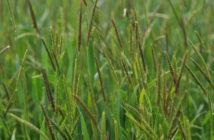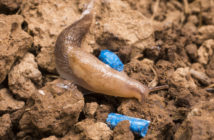There are often mixed views about the value of biostimulants to arable crops, but work by leading agronomy firm Hutchinsons shows they can benefit wheat yields if the correct product is applied at the optimum time.
Trials over several years show phosphite-based biostimulants, such as Phorce and Advance 66, can be particularly beneficial for improving tiller retention in winter wheat, providing they are applied early enough in the season.
Hutchinsons technical manager Dick Neale says this is because phosphites effectively “trick” root tips into thinking they are short of phosphate, which in turn stimulates an increase in lateral root development. For this to have a beneficial effect on yield, phosphites must be applied in time to build root mass before plants start to shed tillers, so autumn and GS 30 are the best timings, he explains.
“Wheat plants generally want to throw off 40% of their tillers between growth stage 30 and 31 as they sort out what can be supported through to harvest.
“Signals from the roots indicating the availability of nutrients play a key role in this process, so if we can increase root mass and the plant’s ability to extract soil nutrients, then they will retain more tillers. More tillers clearly leads to more grains/m2 at harvest.”
In Hutchinsons trials, two applications of Phorce in autumn and at GS 30, gave a yield benefit of 0.5t/ha over the untreated.
Once wheat gets beyond GS 31, applying a phosphite-based biostimulant has little or no effect as plants will have dropped tillers by this point, he warns.
Growers should therefore always use growth stage to determine application timing for biostimulants, rather than going by fungicide timings, he says. For example, if the T1 fungicide timing is used as the cut-off, this will be too late for biostimulants to work effectively, as many T1s are applied at GS 32, by which time tillers will have been lost.
“You’ve got to understand how biostimulants are impacting on the plant. All too often, the reason they don’t work is because people have applied the wrong product at the wrong time.”
Plant health benefits
Plants with strong root systems and a better ability to take up nutrients are likely to be healthier and more resilient to stress, foliar diseases, and lodging, Mr Neale says.
He highlights research that shows how applying biostimulants to build more root mass can also mitigate the effects of take-all.
“This might be particularly relevant this year as there are a lot of crops that are effectively second wheats after following spring barley or spring wheat growers were forced to drill last season.”
Regarding lodging, he says many problems in the UK are due to root lodging rather than stem lodging, so strengthening the root plate gives more anchorage which should keep crops standing.
The zinc ammonium complex included within Advance 66 offers additional benefits for how efficiently applied ammonium nitrate is converted into useable forms within the plant, he adds. “This conversion can be an energy-hungry process for the plant, so improving efficiency allows more energy to go into roots and tillers.”
Other research shows particularly useful plant health benefits from applying the metabolite-based product, Scyon, in winter wheat. The product works in a completely different way to Phorce or Advance 66, as it stimulates the plant’s host response to disease attack. Coupled with a good fungicide programme, the product has given consistent yield benefits where disease is present, notably Septoria.
“The yield response can be more hit and miss in low disease pressure situations, as you are then only reliant on the biostimulant effects on the roots, which can be influenced by many other external factors.”
Later timing
While phosphite-based biostimulants should be applied early in the season for best effect, Mr Neale says there are other options suited to later applications around the flag leaf timing (GS 39).
Products such as YieldOn work by increasing the transfer of metabolites from the stem into the grain, and have been shown to give a more consistent yield response, as there are fewer variables to influence the effects than with biostimulants targeted towards improving rooting.
“We’ve regularly seen a 0.3-0.4 t/ha yield benefit, so it is something to consider at this later timing.”
Mr Neale concludes: “Do not fall into the trap of thinking all biostimulants are the same. If you are committed to using them, make sure you understand what each does and why you are using them.”




